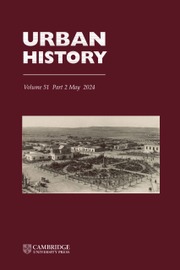Article contents
Rateable Assessment as a Data Source for Status Area Analysis: the Example of Edinburgh 1855–1962
Published online by Cambridge University Press: 09 February 2009
Abstract
Research has revealed spatial segregation of status groups to be characteristic feature of many urban settlements. Sjoberg has identified such areas in pre-industrial cities although many have argued that marked spatial segregation primarily occurred in post-Industrial Revolution cities. Much interest has surrounded detailed analysis of settlements, or parts thereof, within particular historical eras, e.g. Victorian studies, but the study of the status areas of a settlement over a longer time period has received less attention. This article resulted from a study of status areas in Edinburgh at three points in time: 1855, 1914 and 1962.
- Type
- Research Article
- Information
- Copyright
- Copyright © Cambridge University Press 1979
References
1. For example: Jones, R., 'Segregation in urban residential districts. Examples and research problems: in Proceedings I.G.U. Symposium in Urban Geography (Lund, 1960);Google Scholar Jones, E., A Social Geography of Belfast (1960);Google Scholar Robson, B. T., Urban Analysis (1969);Google Scholar Morgan, B. S., ‘The Residential Structure of Exeter’, in Gregory, K. J. and Ravenhill, W. (eds), Exeter Essays In Geography (1971), 219–35;Google Scholar Johnston, R. J., ‘The location of high status residential areas’. Geografiska Annaler xlviiB (1966), 23–35.CrossRefGoogle Scholar
2. Sjoberg, G., The Preindustrial City: Past and Present (1960).Google Scholar
3. This topic is debated in Langton, J., ‘Residential patterns in pre-industrial cities: some case studies from seventeenth century Britain’, Transactions Institute of British Geographers, lxv (1975), 1–27.CrossRefGoogle Scholar
4. A notable exception is the study of Sunderland by Robson, op. cit.
5. Gordon, G., ‘The status areas of Edinburgh: an historical analysis’, Ph.D.thesis, University of Edinburgh, 1971).Google Scholar
6. Saunders, L. J., The Making of the Scottish Democracy: 1815–40 (1950), 89.Google Scholar
7. Keir, D. (ed.), The Third Statistical Account of Scotland, vol. 15 (City of Edinburgh, 1966), 374.Google Scholar
8. Notably by Robson and Morgan, op. cit., and Williams, W. and Herbert, D. T., ‘The social geography of Newcastle-under-Lyme’, Staffs, N.. Journal of Field Studies, (1962), ii 108–26.Google Scholar
9. Robson, op. cit., 106.
10. Extensive discussions with senior members of the Assessor's Department of Edinburgh Corporation confirmed the accuracy of post–1854 valuation data.
11. References in n. 8 discuss this topic.
12. Models based upon bid rent theory.
13. Resulting from the work of human ecologists based at the Dept of Sociology, University of Chicago, in the 1920s and 1930s.
14. Historical studies frequently encounter criticism because of an absence of theoretical framework. An example is Whitehand, J. W., ‘Urban historical geography or scholars and social scientists’, Area, vi, 4 (1974), 254–6.Google Scholar
15. Burgess, E. W., ‘The growth of the city: an introduction to a research project’, Papers and Proceedings of the American Sociological Society, xviii (1924), 85–97.Google Scholar
16. Hoyt, H., The Structure and Growth of Residential Neighbourhoods in American Cities (Washington DC, 1939).Google Scholar
17. Holmes, R. S., ‘Identifying nineteenth century properties’, Area, vi, 4 (1974), 273–7.Google Scholar
18. Kirkwood, R., Plan of Edinburgh, 1817.Google Scholar
19. Considerably location precision was attainable from the Post Office Directories which locate street intersections and indicate the direction of numbering. Thus reasonable exactness could be achieved solely based upon the directories and large-scale maps giving detailed plot boundaries.
20. Keir, op. cit., 59.
21. Gray, R. Q., The Labour Aristocracy in Victorian Edinburgh (1976).Google Scholar
22. Some 1, 400 houses were constructed over a 30-year period. Many were sold on Instalment basis at prices ranging between £130 and £250 per unit.
23. Briggs, A., Victorian Cities (1968), 33–4.Google Scholar
24. A recent attempt to link these different data sources occurs in Fox, R. C., ‘The morphological, social, functional development of the Royal Burgh of Stirling’, (Ph.D. thesis, University of Strathclyde, 1978).Google Scholar
- 2
- Cited by


